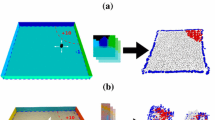Abstract
To interact with the external environment, robots represent it as a state using sensor data. In this study, we present a state representation based on noisy sensor data using distances among probability distributions. Our proposed representation is not influenced by environmental changes, that is, sensor signals maintain an identical state even after certain environmental changes. We represent sensor signals as probability distributions and the distances between such distributions express a state. To confirm the effectiveness of our proposed state representation, we conducted experiments using a mobile robot with distance sensors. Experimental results confirmed that our proposed representation correctly recognizes similar states using a converted sensor signal.














Similar content being viewed by others
Notes
BD(p i ,p j )=−log∫(p i (x)p j (x))1/2 dx=−logf div (p i ,p j ).
The distance between the robot and the wall was less than 25 mm.
In this investigation, sensor signals were not transformed by Eq. (5).
References
Asada M, Noda S, Tawaratsumida S, Hosoda K (1996) Purposive behavior acquisition for a real robot by vision-based reinforcement learning. Mach Learn 23:279–303
Csiszár I, Shields PC (2004) Information theory and statistics: a tutorial. Now, Boston
Duchon AP, Kaelbling LP, Warren WH (1998) Ecological robotics. Adapt Behav 6(3–4):473–507
Fitzpatrick P, Metta G, Natalc L, Rao S, Sandini G (2003) Learning about objects through action—initial steps towards artificial cognition. In: Proceedings of IEEE international conference on robotics and automation (ICRA03), pp 3140–3145
Gibson JJ (1979) The ecological approach to visual perception. Houghton Mifflin, Boston
Gouko M, Ito K (2010) A fundamental study of state representation for robots using f-divergence. In: Proc. of 4th international symposium on measurement, analysis and modelling of human functions, pp 84–89
Gouko M, Tomi N, Nagano T, Ito K (2010) Behavior emergence model based on change in sensory information and its application to multiple tasks. Int J Robot Autom 25(1):57–66
http://www.e-puck.org/ (2011)
Ito K, Fukumori Y (2006) Autonomous control of a snake-like robot utilizing passive mechanism. In: Proceedings of the 2006 IEEE international conference on robotics and automation (ICRA06), pp 381–386
Kohonen T (1995) Self-organizing maps. Springer, Berlin
Nakamura T, Asada M (1995) Motion sketch: acquisition of visual motion guided behaviors. In: Proceedings of international joint conference on artificial intelligence, pp 126–132
Qiao Y, Minematsu N (2008) f-divergence is a generalized invariant measure between distributions. In: Proceedings of 10th annual conference of the international speech communication association, pp 1349–1352
Qiao Y, Minematsu N (2010) A study on invariance of f-divergence and its application to speech recognition. IEEE Trans Signal Process 58(7):3884–3890
Sutton RS, Barto AG (1998) Reinforcement learning: an introduction. The MIT Press, Cambridge
Takamuku S, Hosoda K, Asada M (2008) Object category acquisition by dynamic touch. Adv Robot 22:1143–1154
Turvey MT (1996) Dynamic touch. Am Psychol 51(11):1134–1152
Ugur E, Dogar MR, Cakmak M, Sahin E (2007) The learning and use of traversability affordance using range images on a mobile robot. In: Proceedings of IEEE international conference on robotics and automation (ICRA07), pp 1721–1726
Watkins CJCH, Dayan P (1992) Q-learning. Mach Learn 8:279–292
Acknowledgements
This research was partially supported by the Ministry of Education, Science, Sports and Culture, Grant-in-Aid for Young Scientists (B), 24700196.
Author information
Authors and Affiliations
Corresponding author
Rights and permissions
About this article
Cite this article
Gouko, M., Kobayashi, Y. A State Representation Model for Robots Unaffected by Environmental Changes. Int J of Soc Robotics 5, 117–125 (2013). https://doi.org/10.1007/s12369-012-0164-9
Accepted:
Published:
Issue Date:
DOI: https://doi.org/10.1007/s12369-012-0164-9




